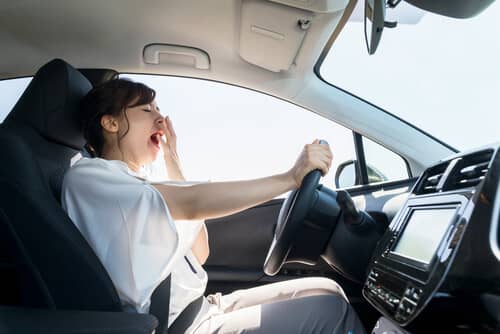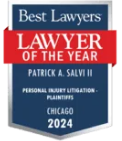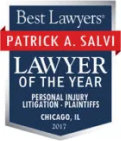
Chicago Drowsy Driving Accident Attorneys
Illinois crash statistics show that 1,268 people died on the state’s roads in a recent year. While that number represents a five-percent decline from the prior year, many of these accidents occurred due to preventable driver behaviors, including drowsy (or fatigued) driving.
According to the National Highway Traffic Safety Administration (NHTSA), drowsy driving claimed the lives of 684 U.S. motorists in just one year. A person who nods off behind the wheel presents a major risk to themselves and others. No law can specifically prohibit drowsy driving. However, a driver who causes an accident while fatigued can still be held legally responsible and ordered to pay damages to victims injured in the crash.
Dangers of Drowsy Driving
Additional NHTSA data on fatigued driving crashes is similarly grim. Consider these facts for a single year:
- An average of 91,000 police-reported wrecks involved at least one drowsy driver.
- Of these collisions, nearly 800 people died and approximately 50,000 people suffered injuries.
NHTSA notes these statistics are likely underreporting how many drowsy drivers hit the road daily. Some experts estimate that as many as 6,000 U.S. traffic fatalities are due to drowsy driving.
Driving while fatigued is likely to cause accidents because drivers may:
- Drift into the wrong lane
- Cross a double yellow line or veer onto the wrong side of a divided highway
- Crash into the vehicle in front of them
- Fail to take their foot off the gas and come to a sudden stop
- Fail to respond quickly enough due to slowed reflexes caused by fatigue
Fatigued Driving Accidents Are More Severe
Accidents caused by driver fatigue can have devastating consequences. In fact, drowsy driving is considered just as dangerous as drunk driving. That’s because fatigue can have similar effects on the body that alcohol does. It impairs coordination, awareness, judgment, and reaction time. Drowsy drivers may not brake or swerve to avoid a collision. Crashes from fatigued driving also occur at higher speeds. A driver who drifts in and out of sleep lacks the awareness and response time needed to slow down or stop. The higher the speed, the worse the injuries tend to be.
Who is at Risk for Drowsy Driving Accidents?
Despite the clear dangers of driving while fatigued, many people still choose to drive when they are tired.
In fact, according to the AAA Foundation for Traffic Safety, two in five drivers in a recent survey admitted to nodding off or even falling asleep behind the wheel. The AAA study also noted the following self-reported statistics:
- Eleven percent of respondents admitted falling asleep behind the wheel in the past year, with four percent falling asleep in the last month.
- Twenty-seven percent of drivers drove while so drowsy they could barely keep their eyes open.
- Over half of drivers who fell asleep behind the wheel did so while on a high-speed divided highway (with more than a 55-mile-per-hour speed limit).
Drowsy driving is something the majority of adults do at least occasionally. Certain individuals, however, may be more likely to drive when they are tired or may be at the greatest risk of becoming involved in a drowsy driving crash.
Teenage drowsy drivers can be a major threat on the road. In a recent study, about 50 to 70 percent of teen drivers reported driving while fatigued, with approximately 15 percent saying they did so at least weekly. The study notes that teenage drivers were the most frequent drowsy drivers but noted that several other types of drivers are also more likely to fall asleep while driving. These include:
- Commercial drivers
- People with sleep apnea
- Shift workers
- First responders and law enforcement officers
NHTSA notes that certain factors put people at a higher risk of being involved in a drowsy driving accident. Drowsy driving collisions usually involve a single driver, driving alone, who drifts off the road, sometimes at a high rate of speed, with no indication of ever hitting the brakes. These types of crashes occur most frequently on highways or rural roads between midnight and 6 a.m. or in the late afternoon. Both are times when the body’s circadian rhythm dips, causing sleepiness.
Those who use medications with a sedating effect, including benzodiazepine anxiolytics, sedating antihistamines, and long-acting hypnotics, are also at risk of causing drowsy driving crashes.
Unfortunately, when teens, shift workers, or others choose to drive when they are too tired (or continue driving despite nodding off or having difficulty concentrating), their poor decisions can also affect other drivers. Therefore, every motorist is at risk of being involved in a fatigued driving accident.
Drivers should be on the lookout for anyone exhibiting potential signs of fatigued driving and be aware of the time when drowsy driving crashes are most likely to happen. According to NHTSA, these times include late nights, early mornings, or mid-afternoon, especially when the driver is alone in the car.
Seeking Compensation After a Drowsy Driving Accident
Unlike drunk driving, there is no clear and easy test to determine when or if a driver was driving while fatigued at the time of a crash. There are also no clear laws specifically banning drowsy driving. For that reason, drowsy driving accidents can become legally complex.
If you or a loved one has been the victim of a drowsy driving crash, you can recover compensation from the driver who hurt you if their negligence led to your injury. Driving while fatigued can be a form of negligent or reckless behavior, especially if no reasonable average driver would have made the choice to drive in that situation.
The burden, however, is on the injured victim to prove that the other driver was negligent in driving while drowsy. For that reason, drowsy driving cases need to be investigated carefully.
Drowsy driving accidents can be investigated by law enforcement and car accident attorneys. Those who wish to take legal action against the fatigued driver can also contact accident reconstruction experts and can look for evidence including:
- Lack of sleep
- Witness testimony of erratic behavior, such as veering across lanes or off the road
- An admission by the drowsy driver that they were fatigued or falling asleep
- Absence of skid marks or other evidence from the accident scene that indicates a failure to attempt to swerve or stop
Building a drowsy driving case and getting the evidence you need can be complicated, so it is crucial to have legal assistance. Contact the drowsy driving accident lawyers at Salvi, Schostok & Pritchard P.C. today for a free consultation.







